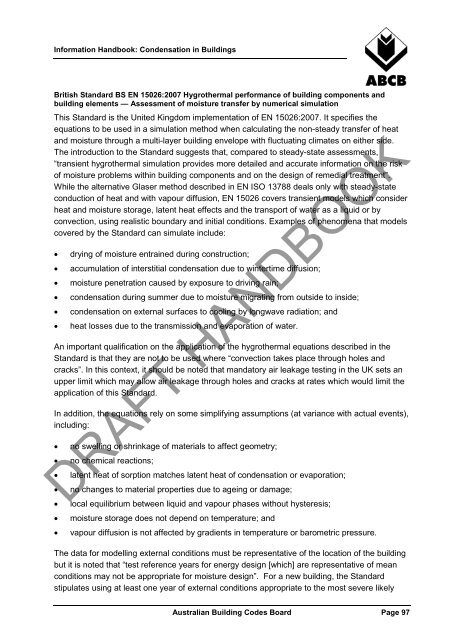Condensation in Buildings - Australian Building Codes Board
Condensation in Buildings - Australian Building Codes Board
Condensation in Buildings - Australian Building Codes Board
Create successful ePaper yourself
Turn your PDF publications into a flip-book with our unique Google optimized e-Paper software.
Information Handbook: <strong>Condensation</strong> <strong>in</strong> Build<strong>in</strong>gs<br />
British Standard BS EN 15026:2007 Hygrothermal performance of build<strong>in</strong>g components and<br />
build<strong>in</strong>g elements — Assessment of moisture transfer by numerical simulation<br />
This Standard is the United K<strong>in</strong>gdom implementation of EN 15026:2007. It specifies the<br />
equations to be used <strong>in</strong> a simulation method when calculat<strong>in</strong>g the non-steady transfer of heat<br />
and moisture through a multi-layer build<strong>in</strong>g envelope with fluctuat<strong>in</strong>g climates on either side.<br />
The <strong>in</strong>troduction to the Standard suggests that, compared to steady-state assessments,<br />
“transient hygrothermal simulation provides more detailed and accurate <strong>in</strong>formation on the risk<br />
of moisture problems with<strong>in</strong> build<strong>in</strong>g components and on the design of remedial treatment”.<br />
While the alternative Glaser method described <strong>in</strong> EN ISO 13788 deals only with steady-state<br />
conduction of heat and with vapour diffusion, EN 15026 covers transient models which consider<br />
heat and moisture storage, latent heat effects and the transport of water as a liquid or by<br />
convection, us<strong>in</strong>g realistic boundary and <strong>in</strong>itial conditions. Examples of phenomena that models<br />
covered by the Standard can simulate <strong>in</strong>clude:<br />
• dry<strong>in</strong>g of moisture entra<strong>in</strong>ed dur<strong>in</strong>g construction;<br />
• accumulation of <strong>in</strong>terstitial condensation due to w<strong>in</strong>tertime diffusion;<br />
• moisture penetration caused by exposure to driv<strong>in</strong>g ra<strong>in</strong>;<br />
• condensation dur<strong>in</strong>g summer due to moisture migrat<strong>in</strong>g from outside to <strong>in</strong>side;<br />
• condensation on external surfaces to cool<strong>in</strong>g by longwave radiation; and<br />
• heat losses due to the transmission and evaporation of water.<br />
An important qualification on the application of the hygrothermal equations described <strong>in</strong> the<br />
Standard is that they are not to be used where “convection takes place through holes and<br />
cracks”. In this context, it should be noted that mandatory air leakage test<strong>in</strong>g <strong>in</strong> the UK sets an<br />
upper limit which may allow air leakage through holes and cracks at rates which would limit the<br />
application of this Standard.<br />
In addition, the equations rely on some simplify<strong>in</strong>g assumptions (at variance with actual events),<br />
<strong>in</strong>clud<strong>in</strong>g:<br />
• no swell<strong>in</strong>g or shr<strong>in</strong>kage of materials to affect geometry;<br />
• no chemical reactions;<br />
• latent heat of sorption matches latent heat of condensation or evaporation;<br />
DRAFT HANDBOOK<br />
• no changes to material properties due to age<strong>in</strong>g or damage;<br />
• local equilibrium between liquid and vapour phases without hysteresis;<br />
• moisture storage does not depend on temperature; and<br />
• vapour diffusion is not affected by gradients <strong>in</strong> temperature or barometric pressure.<br />
The data for modell<strong>in</strong>g external conditions must be representative of the location of the build<strong>in</strong>g<br />
but it is noted that “test reference years for energy design [which] are representative of mean<br />
conditions may not be appropriate for moisture design”. For a new build<strong>in</strong>g, the Standard<br />
stipulates us<strong>in</strong>g at least one year of external conditions appropriate to the most severe likely<br />
<strong>Australian</strong> Build<strong>in</strong>g <strong>Codes</strong> <strong>Board</strong> Page 97
















